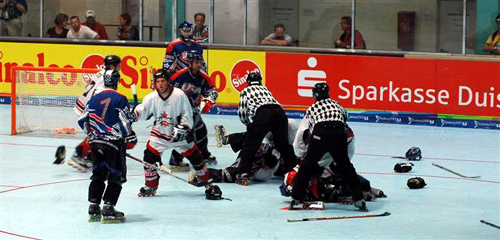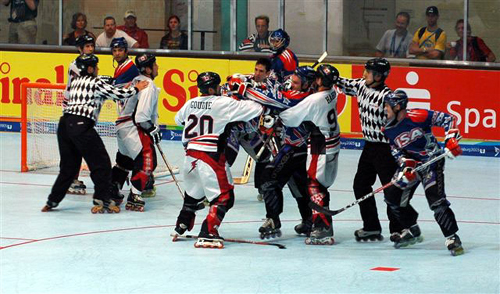{gallery}{/gallery}
Ice hockey has paid a considerable price in public consciousness for its tarnished image from brawling and gratuitous violence associated with past NHL televised games. A few decades ago, this influence on amateur hockey led to the collapse of high school and youth ice hockey programs, as civic leaders and educators decided from similar infections in their programs that the lessons being learned from NHL admirers were not associated with their own organizational goals. This, coupled with rising energy costs to maintain ice facilities, resulted in wholesale closings of ice rinks in the northern tier of the
This is what CIRILH wants to avoid

Unfortunately, to many involved with this sport, the tradition of violence in hockey dies slowly. Some feel that the game of hockey provides them with license to vent frustration or anger by savage attacks on opponents that would get them arrested for assault if occurring off the rink. Toleration of such conduct by inline hockey would do untold damage to its future, because parents in their right mind would never insert their child in an environment where they might be severely injured by league sanctioned game thuggery. Game organizers must be swift and substantial in their punishment for such conduct.
It has been my experience that there will always be a few players or coaches that will try to win games at any cost, by bad conduct or poor sportsmanship, when they find they can not prevail by the rules. Fortunately for amateur sports, such individuals and teams are in the minority, but can still cause chaos and difficulty for those trying to play by the rules. I have come to believe continual bad conduct by a team would not exist without the complicity of the team coach, and, in some cases, abetted by game referees. A coach’s culpability is obvious, because he is certainly not oblivious to violent tendencies by certain players. When bad conduct on his team is the norm, whatever the provocation, then it must be assumed that this is a direct reflection of his or her coaching philosophy. Such cancers can not be allowed to infect our sport or to discourage teams, athletes and their parents from involvement with inline hockey by opting not to join our local leagues, tournaments and championships. There is a strong reaction in our playing rules toward bad conduct on the rink. When not applied, a mere slap on the wrist to some players is well worth the price of a coerced victory. It may even be necessary, under extreme circumstances, for a league to suspend an entire team and coach for gross misconduct.
An excellent referee must early in the game establish his authority and the rule of law, by an unbiased and even handed application of the rules, before player actions be allowed to get too far out of hand. Once this evil genie is released from the bottle, it is impossible to return the cork and regain control. If a player believes that an opponent is going unpunished for a foul committed against him, then retaliation in kind or even worse is almost inevitable. A referee who is hesitant to apply the rules out of intimidation by star teams or players or who is unsure of his knowledge of the game and the rules, will very often prefer not to act when he sees anything but an obvious or overt foul. The referee thus creates his or her own hell on the rink. When a referee is seen to be inconsistent or seemingly partial to the other team with inconsistent application of the rules during a game, or engages in vocal arguments with the players or the bench, he or she inspires retaliation on the part of that team, because the injured party adopts the belief that only through violence can the team obtain "justice."
Another bad thing CIRILH wants to cancel

After decades of being a sport administrator, I have noted an interesting paradox in writing and applying sport rule punishments. The more stringent that you make these rules, the less inclined officials are to apply them. Most referees are not conscientious enough in giving out match penalties for closed fist punching during games. An interesting sidelight to Chris Simon’s NHL 25-game suspension is to note that the game referee assigned only a 5-minute major to the offense, not a game misconduct. Under our rules, the severity of most penalties are to be assigned at first by the discretion of the floor referees, able to recognize who actually instigated the fight and what transpired. A referee needs cool-headed assurance that comes from a through knowledge of the rules and a great deal of experience in high caliber games, to muster the courage necessary to put out of a match an offending team's aggressive star player. Referees must take a lesson from the Mikado and “let the punishment fit the crime."
However, match penalties, when imposed in the last minutes of a team’s final game of a tournament, have no real sting or deterrent power to a player or team. The more pugilistic players know this, and therein lies a major problem for enforcement of good conduct. Restraint is not exercised when players feel that they may release their pent up aggressions in the final minutes of a tournament without fear of serious consequences. Leagues must take steps to review these situations and deal out suspensions according to the seriousness of the condition. In addition, no tournament or league award should be presented to members of a team who are given match penalties. Organizers of such tournaments must be restricted to presenting medals only to those players who remain in good standing at the end of the competition.
Players and parents should respect our concern that inline hockey does not adopt the gratuitous violence associated with NHL professional ice hockey. An endorsement for such action must have the support of the vast majority of inline hockey players, teams, leagues and parents. Some of our best traveling teams are heavily invested in players and coaches who are or once were ice hockey players and may have acquired a different style of conduct than is expected in our games. A few older players, with careers in ice hockey, are skilled in fighting and may be attracted to continuing with inline hockey after they are past their ice prime, because they like to hit people. Failures to comply with the no violence rules must be weeded out. We should all be anxious to eliminate game bestiality and preserve future growth for our sport.





